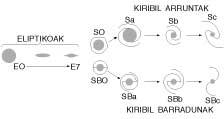Hubble Galaxy Classification
1991/01/01 Arregi Bengoa, Jesus Iturria: Elhuyar aldizkaria
In the third decade of this century a very important debate was decided among astronomers. C.P. 1924 Hubble was able to identify some primes in the star system that were then called “Andromeda Nebula.” Since the behavior of variable stars called cefeides was quite known, Hubble managed to measure the distance to Andromeda.
The value of distance undoubtedly demonstrated that Andromeda was another galaxy outside our galaxy, against those who believed that the French Way or the Milky Way was unique in the Universe. Following his work, E.P. Hubble published in 1926 the classification of galaxies from photographs taken with the Mount Wilson telescope. They still knew little about galaxies. Therefore, the classification is morphological. Hubble himself renewed his classification in 1936 to present it with the aspect we will analyze.
Later, as the number of galaxies catalogued has increased, more efforts have been made to improve the classification, but that of Hubble has not lost the present. First, we will briefly analyze this classification of galaxies and then discuss the current efforts to explain the formation of the different types of galaxies that appear in this classification.

Speaking of the French Way we gave information about its forms and other peculiarities, but these notes cannot be generalized at all, because not all galaxies are like ours. Not everyone has enveloping arms and there are others that appear to us without any structure. However, because of the aspect of these arms, the most abundant are the so-called spirals.
Although these claims cannot be too precise, astronomers consider that the number of galaxies in the field of observation of the largest telescopes could be around 100 billion (note that the depth of this area is currently estimated at 12 billion light years). Undoubtedly, more than half of the galaxies (up to 75%) are spirals. 20% of the rest are elliptical and 5% irregular.
As can be seen in the figure, spiral galaxies form two groups: the most common (type S) and the most blunt (type SB). In the former the spiral structure is formed in the core itself. The second ones, on the contrary, have a bar that leaves the core and the arms leave the latter. The galaxies S and SB are divided into subgroups a, b and c: those of subgroup A have a large nucleus and the thin and indefinite arms; those of subgroup C the nucleus is very small and the strong arms; those of subgroup B are intermediate between the other two. The French Way could be between the last two. Normally, spiral galaxies are made up of large amounts of interstellar matería and many young and luminous stars.
Elliptical galaxies, represented by an E, are also called by their appearance. They are divided into eight groups based on their ellipticity, from EO to E7. The number assignment is done by the formula, where a and b are the measurements of the main and small axis of the galaxy in the form of ellipse. When a and b are equal, the galaxy looks in the form of circumference and is EO type. At first it was thought that elliptical galaxies had the form of vikombexas lenses, when ellipticity was considered a characteristic subordinated to the relative positions of the observer. Today this simplistic interpretation cannot be accepted.
N = 10 (1 - b / a)
Galaxies have been seen in the form of ellipsoid, cylinder or almond and are believed to be much more complex and varied. Otherwise they do not have defined their internal structure. The center is very bright, but its brightness decreases rapidly when going out. In the center there could also be young stars, but most are in very advanced evolutionary states. These galaxies hardly have interstellar matter.
As can be seen in the image, between elliptical and spiral galaxies are OS galaxies, with their intermediate differences. They have a different disc than elliptics, but in it they have no arm.
Finally, we have irregular galaxies. They have no symmetry, often lack core and lack spiral structure. In general they are small and have a lot of interstellar slaughter. Two types are distinguished: Type Irr I and Irr II. The former have very low surface luminosity, have numerous H II clouds and the stars can be easily distinguished inside. Magellanic Clouds are such an example. The surface luminosity of the Irr II is high, often crossed with dust strips and it is not possible to differentiate the stars from the interior with the larger telescopes.
The exploding M82 galaxy is the example of this group. As in the case of the last galaxy we have mentioned, the appearance of some irregular galaxies could be due to intense internal activity. Others are satellites of larger galaxies whose gravity field would be the cause of the deformation of the structure they could have before.
Hubble's classification was initially considered an evolutionary sequence: galaxies would be the first elliptical, then evolving into a spiral. Today it is almost fully assumed that this idea is wrong. All galaxies were born at the same time, without evolving from one type to another. If accepted, the parameter that delimits how the galaxy will be is the reason between the time gas needs to create the star and the time a large cloud needs to become a galaxy.
If the stars are formed earlier by the state of the gas, the kinetic energy generated by the collapse remains in the star (in its movements). Since the interactions between the stars are very scarce, a spherical or ellipsoidal star system would form in the background. If the formation of the stars was the slowest of the two, the collapse generated by the gravity field would cause the formation of the disc, losing kinetic energy in the process (interactions between parts). The stars would then form on the disk (without ceasing but few) and a spiral galaxy would form.
The key is therefore in the process that delimits the reason for the times mentioned. This problem was faced by G. Lake and R.G. Carlberg simulates galaxy creation dynamics with the Cray X-MP supercomputer. These scientists have analyzed the dynamics of a 10,000 fractions model. This model analyzes the behavior of gas in the background of dark matter, including the formation of stars. Dark matter accounts for 90% of the total mass.
From the results obtained a couple of years ago it follows that the distribution of the star and the gas differs according to the speed of the fractions of dark matter. If this speed is low, the collapse of dark matter is easier and the energy and angular momentum are divided between fractions. Transferring out of the angular moments is very important. As is known, the angular moment acts against gravitational force. Therefore, once transferred to the outside, in the central regions the stars are easily formed and we are in the case of the formation of elliptical galaxies.
If the fractions speed is high, the collapse is not so easy or the transfer of the angular momentum. Therefore, the formation of stars is slower and spiral galaxies can form. Moreover, it is perfectly logical that spiral galaxies have a greater angular momentum than elliptical galaxies, as has been demonstrated experimentally.
What is not entirely clear is what limits the distribution of velocities in dark matter. On the other hand, very few parameters are considered and few have been studied among their possible values, but the work clearly demonstrates the importance of dark matter in the formation process of galaxies.
EPHEMERIS SUN: Enter Pisces on February 19 at 3 and 58 (UT).
PLANETS
|

Gai honi buruzko eduki gehiago
Elhuyarrek garatutako teknologia



